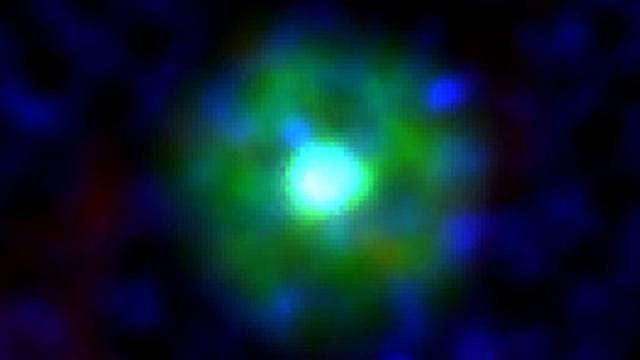Space is full of surprises, like this apparent star — which, given the tumultuous circumstances of its formation, shouldn’t really exist.
New research published in Astronomy & Astrophysics describes a potentially new kind of star, one born in an event typically associated with destruction rather than creation: the merger of two white dwarfs. The paper, co-authored by astronomer Lidia Oskinova from the University of Potsdam, adds to our understanding of this system, called IRAS 00500+6713, which caught the attention of astronomers back in 2019.
Indeed, this strange celestial case is providing astronomers with “new evidence of possible scenarios where supernova-like explosions are produced without completely destroying the exploding object,” Josiah Schwab, a theoretical astrophysicist at UC Santa Cruz who’s not involved with the new study, explained in an email.
White dwarfs are the dense, shriveled remnants of dead Sun-like stars. Pairs of white dwarfs often come together, resulting in a large stellar explosion known as a type 1a supernova. This was the case for IRAS 00500+6713, but the explosion wasn’t strong enough to destroy the system; instead, it resulted in the formation of an unknown type of celestial object, the new research suggests.
That IRAS 00500+6713 is somehow unusual was readily apparent to the scientists who originally described the system in 2019. It consists of a super hot central star, named J005311, surrounded by a nebula packed with hot gas and warm dust. The star contains lots of oxygen and carbon, but the speed of its stellar winds is off the charts, clocking in at 16,093 km per second. In an email to Gizmodo, Oskinova said no other object like this has ever been seen before. Indeed, the object, which was observed in infrared, seemed way too luminous to be a white dwarf, prompting the new research.
Using the European Space Agency’s XMM-Newton space telescope, Oskinova and her colleagues noticed that the nebula shines brightly in X-rays and contains a large amount of the element neon.
“Our X-ray observations made it possible to determine the chemical composition of the nebula, and strongly improved our knowledge of the chemical composition of the central star,” explained Oskinova. “We found that the system contains a lot of neon, silicon, and sulphur. Furthermore, X-ray observations revealed that the nebula is filled with a very hot gas at the temperature of a few millions degrees, and the central star is also a source of X-ray emission.”
Theoretical modelling suggests this object is the result of two white dwarfs coming together. The heavier white dwarf pulled matter away from the lighter companion, eventually triggering a supernova explosion — but one too weak to destroy the system entirely. At the same time, however, the explosion was still strong enough to eject significant amounts of material. Oskinova and her colleagues believe the neon-rich nebula is that ejected material, and that a cohesive object managed to survive the the weak supernova, allowing it to develop into the star we see today. At least, according to this scenario.
“IRAS 00500+6713 is a newly discovered type of celestial object. We are not aware of other objects with similar properties.” said Oskinova. “We can call it a very unusual star.”
The team wasn’t able to determine the object’s mass, but its high luminosity is consistent with an object heavier than 1.4 solar masses, which is the upper limit for a white dwarf (any heavier and it transforms into a neutron star).
Schwab said the new X-ray data and subsequent analysis improves our knowledge of the object’s chemical composition.
“The results suggest the involvement of an oxygen-neon white dwarf and the occurrence of carbon fusion, both of which strengthen the case that this particular object is a massive remnant of the merger of two white dwarfs,” he explained.
Future work, said Schwab, including both theoretical modelling and observations of the nebula, will be required to fully understand the nature of the explosion that produced the unusual star. Indeed, in addition to a new kind of star, these researchers have likely stumbled upon an entirely new kind of supernova explosion.
Interestingly, Oskinova expects these objects to be quite common in our galaxy. Stars like this have eluded detection for so long probably because they evolve very quickly and are relatively short lived. And indeed, IRAS 00500+6713 is expected to collapse into a neutron star at some point within the next 1,000 years. This “will be accompanied by another, second supernova,” said Oskinova.
Cool! We’ll be watching.
